-
Posts
1,437 -
Joined
-
Last visited
Content Type
Profiles
Forums
Gallery
Events
Posts posted by Mike Y
-
-
Danny, thanks for such a detailed log! It's an endless source of inspiration and hints for less experienced builders, like me

P.S.: the color scheme is interesting, I'm thinking about POF model with similar wood combination - swiss pear frames and beams, boxwood hull and deck planking, mixed wood for fittings. Your log gives a very good overview of that color combination!
-
Sorry for jumping into that topic, but if somebody wants a latest generation kit with a proper shields - I decided to sell mine: http://modelshipworld.com/index.php?showtopic=6268
Von Kossa, sorry again, if you want, I will remove that message. Just posted it here because there is a nice group people interested in Oseberg model here

-
Ouch! Testing in production
 but it only means that next iteration wou,d be much better. Look on Dubz, he screams the word DECONSTRUCTION every now and then, re-making some build steps again and again, and result is incredible!
but it only means that next iteration wou,d be much better. Look on Dubz, he screams the word DECONSTRUCTION every now and then, re-making some build steps again and again, and result is incredible!That planks should bend quite normal, I used an iron to heat them, and soaked in a hot water for an hour before bending.
But be careful with the direction of a wood fibers, mahogany strip will break if you bend it along the fibers... And also dry the planks before installing, they absorb skme water while soaking, and then shrink back. If you glue them while they are still soaked - nasty gaps will appear.
Good luck!
-
Wow, that is a very clear planking, properly levelled, no gaps, amazing!
-
Drilled the holes with dremel. In hindsight, I should have done better job marking holes for treenails, they are no properly aligned into straight lines. But dremel is quite suitable for such drilling. I really want to use something lighter then dremel, but it would be just nice to have.
-
-
Wow! Chuck, thanks for all that ideas! Sounds interesting, will try it. Will probably leave frames as is, they look quite good in sqaure profile, would look worse if "flattened". But the cap rail will be as thin as possible!
Curved molding for backseat would be a challenge with that ultra soft wood, but will try it

-
Btw, there is a real shortage of a wide planks for floor and platform on the back of the ship. I used one of them for a hull gap plank, as advised, and there were just 4 planks remaining. While you need around 5 at least!
Also, while planning the next steps, found some mysterious Extra Details. Spent 30min re-reading whole manual, cant find what that could be. It is thick and, probably, should be mounted on a keel. Chuck, could you please give a hint, that are these pieces for?
Two right ones on this sheet of laser cut details:
-
Important milestone achieved - removed frame centers:
Frames are quite thick, not sure why. Manual says that they should be later sanded down. Probably they would be too fragile otherwise
After sanding, looks quite neat:
Hull is extremely light, it feels like an egg shell. Just 20gr (0.705oz)!
Amount of sanding required really reminds me on an old anecdote about Japanese spies stealing blueprints of Soviet jet fighter, which looked more like a steam locomotive after assembling. There was a small fine print in the manual - sand down some material to shape it like a jet fighter....

- fatih79, fnkershner, Ryland Craze and 1 other
-
 4
4
-
Which scroll saw is not very big and the most silent? I'm a living room modeller, was thinking about a dremel moto saw, but checked some youtube reviews and it sounds extremely loud. Or on a low speed with a thin material it would be fine?
-
Thanks a lot for a warm words
 It is very inspiring!
It is very inspiring! -
-
Applied stain. Hat tip Amfibius, with wipe on method it's much better:
Some spots on a bow do not soak any stain. I tried to scratch and gently sand them to "open" fibers, but no luck.
Then added a coat of a wipe-on poly. Reflections are not as strong in real life, it's just a lamp that I use when taking photos

Whole staining experience confirmed that the best stain is no stain, good wood do not require any staining, just a gentle cover of a poly.
Now looking forward to inner hull sanding!
Also ordered boxwood longboat, will do the next build better then this one

- fatih79, Mirabell61, mrshanks and 4 others
-
 7
7
-
Finished treenailing and sanding. Sanded with 240 -> 600 -> 1200 grits, the result is kind of smooth (if you can say that about that wood).
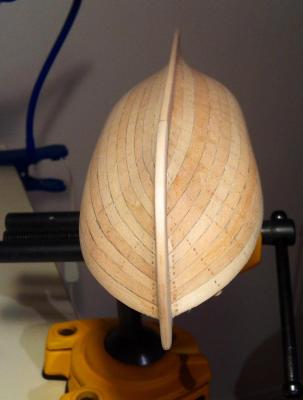
The stains here are not glue or dirt, it is really such wood first and last experience with cheap wood for planking.
first and last experience with cheap wood for planking.
But luckily my staining experiments show that stain will smoothen the wood color a bit.
Also planked the transom: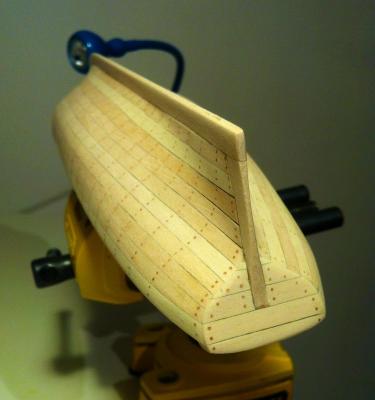
Now the most tricky part - painting. If I do it wrong - whole build is trashed and will deserve a good old viking funeral!
-
Oh, I am such a newbie in anything that is related to paints!
 Thanks, Amfibius, will try now
Thanks, Amfibius, will try now -
Wow, such a nice model in just 3 months! Unbelievable! Good luck with next one!
-
Experimented with different stains. Found a terrible problem - basswood expands when it soaks the stain. Wood is warped and there are big gaps when it dries. Luckily it was just a scrap piece.
What to do? Avoid staining basswood at all? I used quite a few drops of stain on a brush, to keep the moisture level as low as possible. But is just soaks the liquid and expands.
Or there is some trick?
-
Natural wood. It is a nice mahogany, not sure if it is a good idea to paint it

-
Checked it - yes, yours is a much better way of making a treenails. But a much trickier one, especially on my size, not sure how can I drill with that angle..
Added your method into bookmarks!
-
Amfibius, thanks for advice!
By the way, what was the benefit of treenailing from inside?
-
Treenailed one side of the ship. Will do same for other side, and then polish and then cover with wipe-on poly.
Question: what is the best way to polish basswood?
Tried a smooth sandpaper, then scraping with sharp blade, still not smooth enough, wood fibers are poking in various directions. Is there any trick? Maybe I should make it a bit wet and the polish? What about different polishing wool or cotton disks that are used with dremel, can you use them with wood?
- Mirabell61, fatih79, aviaamator and 1 other
-
 4
4
-
- fnkershner and fatih79
-
 2
2
-
Treenail imitation in progress. It turned out to be faster then I thought, average speed is about a hundred nails per hour, including drilling. Holes are 0.60mm, I did a series of tests on scrap planks, 0.60 is the best looking compromise. 0.70 too big, while 0.50 is too tight, a lot of glue is not getting into the hole, some nails fall off.
Nice hedgehog

The trickiest part would be cutting off the toothpics and remainings of glue, with a very little sanding. Some planks are too thin after previous hull sanding..
Hobby knife should do the trick!
- aviaamator, Mirabell61, fatih79 and 2 others
-
 5
5
-
- fnkershner, aviaamator, Chuck and 2 others
-
 5
5


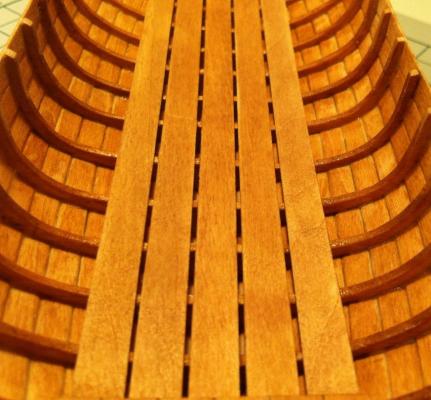

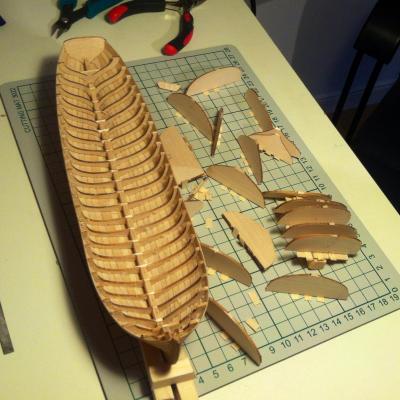
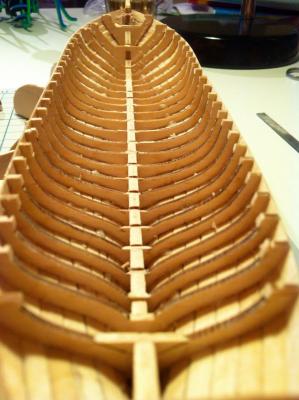
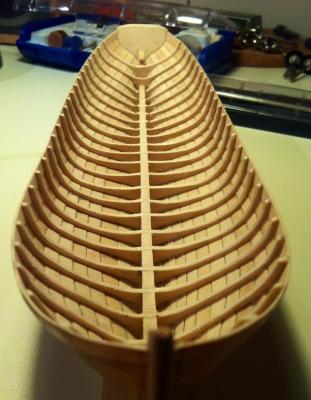
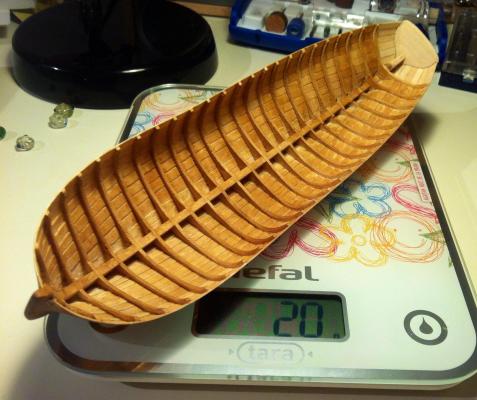
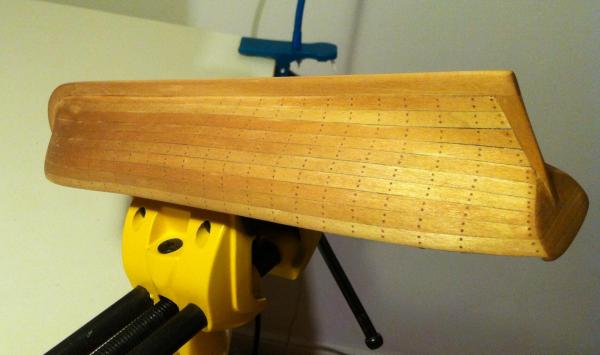
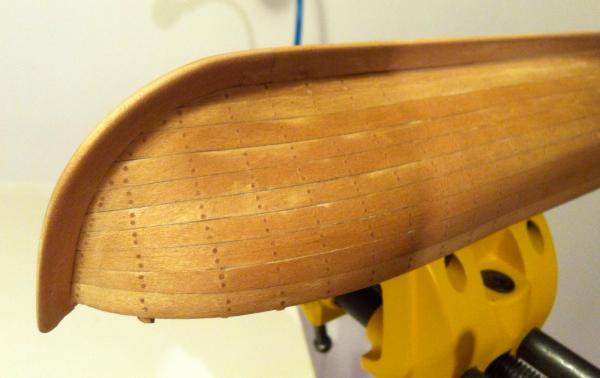

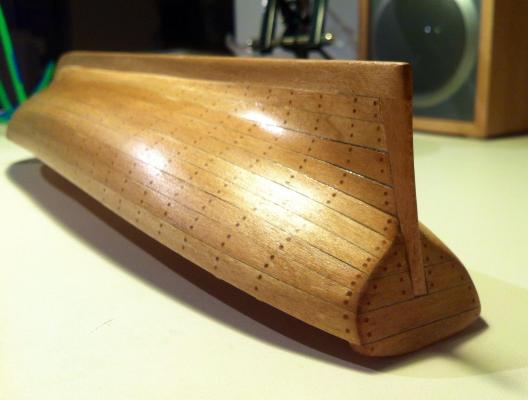
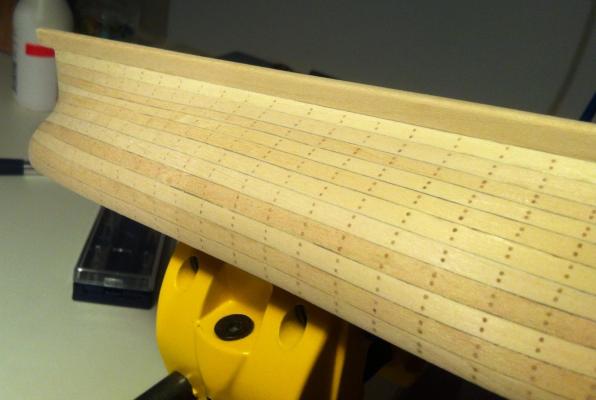

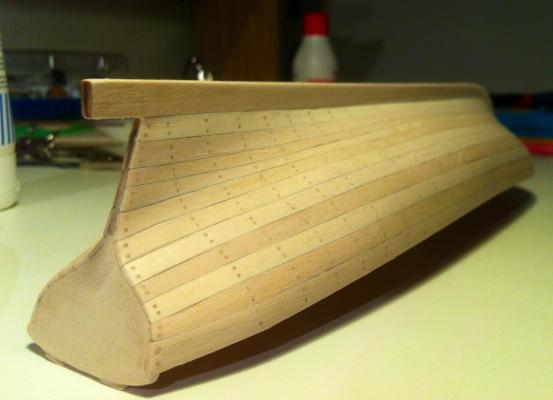
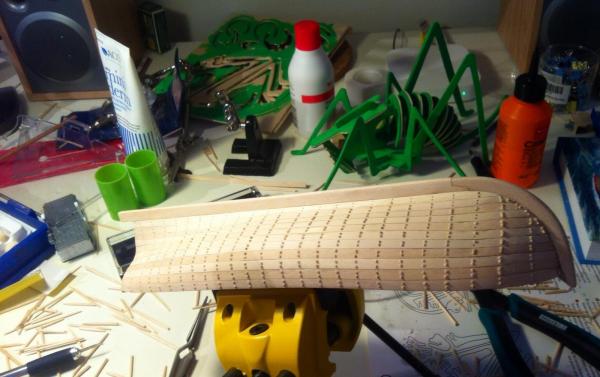
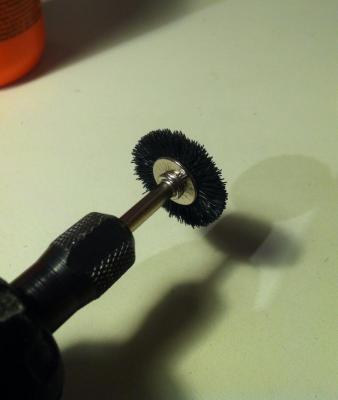
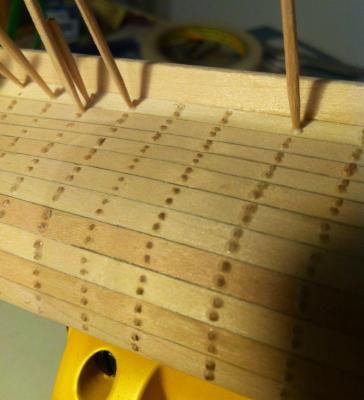
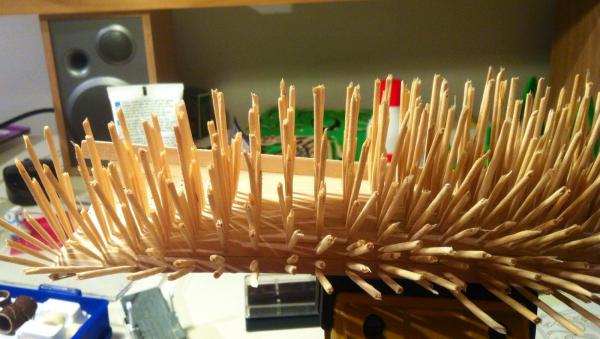

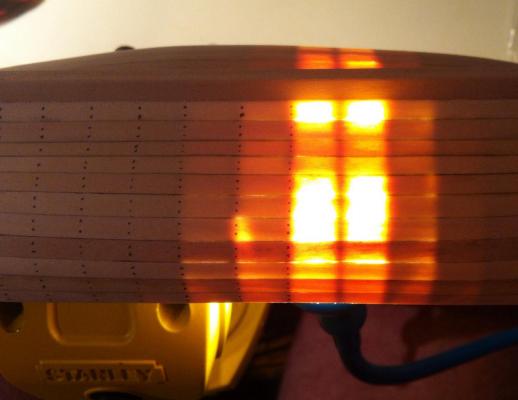
21ft English Pinnace by Mike Y - FINISHED - Model Shipways - 1:24
in - Kit build logs for subjects built from 1751 - 1800
Posted
Had no time to model for a month, but now finally back to the bench!
Installed the risers, it required a better fairing of the frames, and I was not risking to clamp them while glueing.
Here comes the nasty part - painting. I truly hate it, my painting skill suck and the whole procedure is extremely risky. That is why I always opt to natural wood color, maybe a bit of stain But this model have a rich red color which adds a style, so there is no choice.
But this model have a rich red color which adds a style, so there is no choice.
I used Galeria Acrylic Crimson paint, same as Chuck. Results are quite ok in places where you can wipe away unnecessary paint with a cloth:
But I totally failed in an area with problematic access, like transom. Well, that would be an experience...
Maybe I should have mixed it with water, to make paint more liquid?